Stunning Swiss sex symbol, starlet and jet-setter Ursula Andress (1936) will always be remembered as the first and quintessential Bond girl. In Dr. No (1962) she made film history when she spectacularly rises out of the Caribbean Sea in a white bikini. Though she won a Golden Globe, Ursula's looks generally outweighed her acting talent and she never took her film career very seriously.
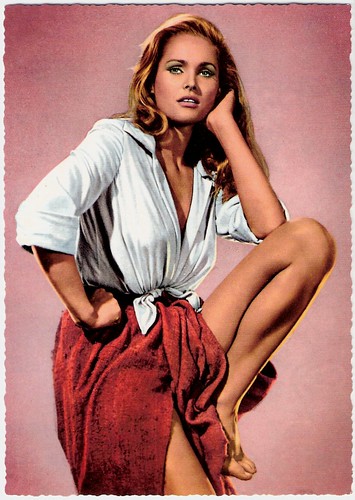
German postcard by Krüger, no. 902/411.
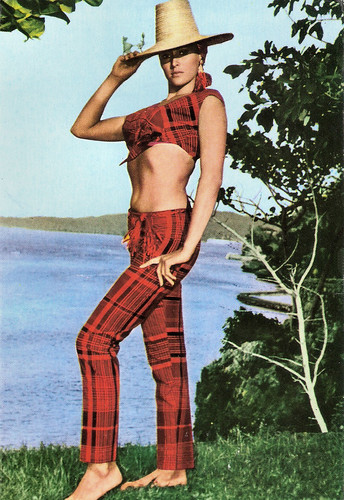
Spanish postcard by Raker, no. 1157, 1965.
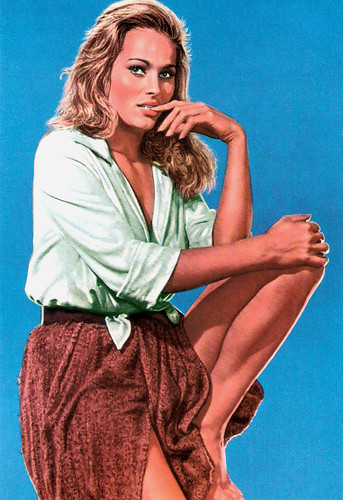
Spanish postcard, no. 240, 1964.
Ursula Andress was born in 1936, in Ostermundigen in the Swiss canton Bern, as one of seven children in a German Protestant family. Her father Rolf Andress was a German diplomat who disappeared during World War II, and her Swiss mother, Anna Andress, was a florist. The third of six children. She has a brother, Arthur and four sisters, Erica, Kàtey, Charlotte and Ruth. She and her siblings were raised by their grandparents. Her younger sister, Kàtey Andress, later unsuccessfully attempted to start a modelling career.
Although often seeming icily aloof, a restless streak early demonstrated itself in her personality, and Andress had a desire from an early age to explore the world outside Switzerland. At 17, she ran away with an Italian actor, then returned home after her mother intervened.
She studied painting, sculpture and dance in Paris. Andress started her career as an art model in Rome, which led to her first roles in the Italian film industry. (Some sources claim that she was on a holiday to Rome at the time). She played small roles in the Italian farces Un americano a Roma/An American in Rome (Steno, 1954), La catena dell'odio/The Chain of Hate (Renato Baldini, 1955) and Le avventure di Giacomo Casanova/Adventures of Giacomo Casanova (Steno, 1955), which focused on her impressive physical attributes.
Eventually, due in part to the patronage of paramour Marlon Brando, she signed a contract with Columbia Pictures and went to Hollywood heralded as the 'New Marlene Dietrich'. Actually the only things she had in common with Dietrich were her (partly) German heritage and her magnificent legs.
In Hollywood she had a troubled relationship with James Dean. One tabloid reported at the time that Dean was learning German so they could "argue in another language". On the day of his death (30 September 1955), Dean asked her to go with him to San Francisco in his Porsche 550 Spyder, but he had to leave Los Angeles without her.
Andress had met actor and pretty-boy John Derek and had fallen in love with him. They married in 1957, and Ursula dropped out of film-making for several years thereafter.
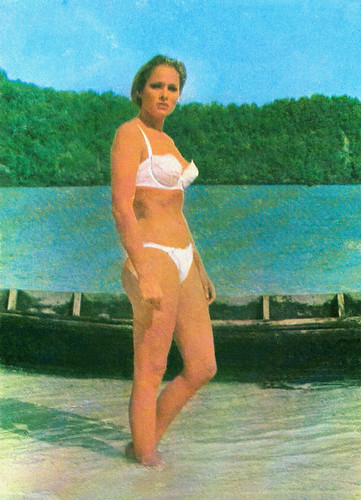
Serbian postcard by Cik Razolednica. Photo: publicity still for Dr. No (1962).
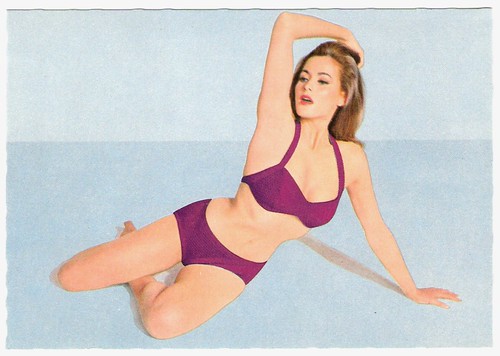
German postcard by ISV, Sort. 12/6.
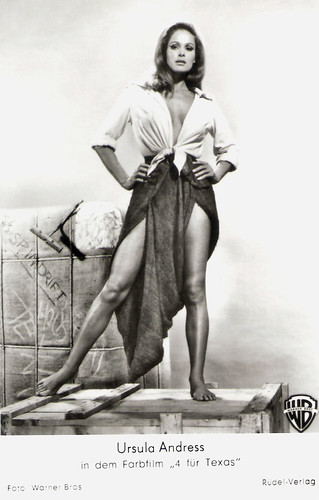
German postcard by Rüdel-Verlag. Photo: Warner Bros. Publicity still for 4 For Texas (Robert Aldrich, 1963).
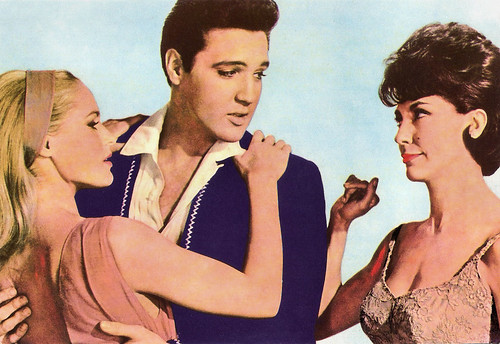
Spanish postcard by Postal Oscarcolor, no. 251. Photo: RCA. Publicity still for Fun in Acapulco (Richard Thorpe, 1963) with Elvis Presley and Elsa Cardenas.

Italian postcard. Photo: Dear Film. Publicity still for Les tribulations d'un Chinois en Chine/Up to His Ears (Philippe de Broca, 1965) with Jean-Paul Belmondo.
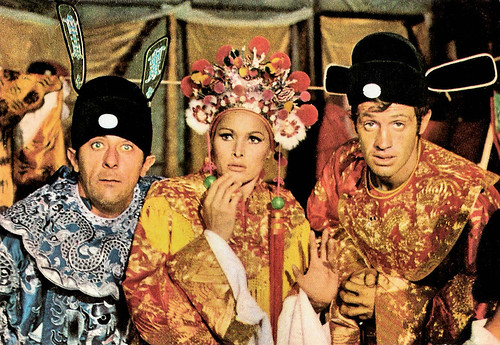
Spanish postcard by Postal Oscarcolor, no. 481. Photo: publicity still for Les tribulations d'un Chinois en Chine/Up to His Ears (Philippe de Broca, 1965) with Jean-Paul Belmondo.
The year 1962 saw Ursula Andress back on the set, co-starring as Honey Ryder with Sean Connery in the first film version of Ian Fleming's James Bond spy novels, Dr. No (Terence Young, 1962).
On a trip to Greece, John Derek had taken photographs of his wife, and one had been published in a magazine. The photograph was seen by Harry Saltzman, co-producer of the first Bond film, which was scheduled to start shooting within a few weeks even though the female lead had not yet been cast. One glance at the picture was enough. Ursula was offered the part.
Her Swiss/German accent was so strong that her voice had to be dubbed, but Ursula Andress' smouldering-yet-aloof screen presence immediately established her as one of the most desired women in the world. Her performance helped to start the James Bond franchise and set the Bond Girl standard beside which all future Bond actresses would be judged.
In 1964 Andress won even a Golden Globe award for New Star of the Year for her role. The success of Dr. No established Ursula Andress as a spectacular ornament to put on-screen alongside the most bankable talent of the 1960s, and she was cast in Hollywood vehicles for such icons as the 'king of rock 'n' roll', Elvis Presley, in Fun in Acapulco (Richard Thorpe, 1963), and Frank Sinatra in 4 for Texas (Robert Aldrich, 1963).
In Europe she starred with Jean-Paul Belmondo in the Jules Verne adventure Les tribulations d'un chinois en Chine/Up to His Ears (Philippe de Broca, 1965) and with Marcello Mastroianni in the SF thriller La decima vittima/The 10th Victim (Elio Petri, 1965), in which she wears a famously ballistic bra.
She also featured as ‘Ayesha - She who must be obeyed’ in Hammer's fantasy film She (Robert Day, 1965) with Peter Cushing and Christopher Lee. In 1965, she also posed nude for Playboy - the photos were taken by husband John Derek. In The Blue Max (John Guillermin, 1966), she was aptly cast as the sultry, sexually insatiable wife of an aristocratic World War I German general, played by James Mason.
Andress also appeared in the Bond satire Casino Royale (John Huston a.o., 1967) as Vesper Lynd, an occasional spy who persuades Evelyn Tremble (Peter Sellers) to carry out a mission. And she was one of several European starlets to co-star in What's New Pussycat (Clive Donner, Richard Talmadge, 1965) - a film that perhaps sums up mid-196’s pop culture best - written by Woody Allen, starring Allen and Peter Sellers, with music by Burt Bacharach, a title song performed by Tom Jones and much on-screen sexual romping.
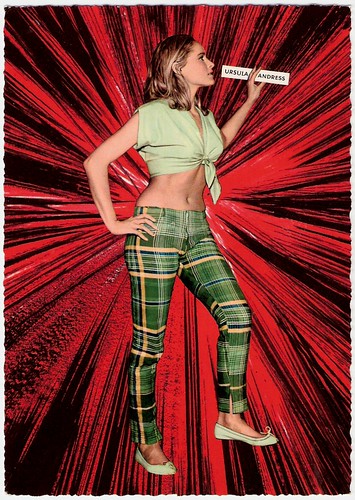
German postcard by Krüger, no. 902/412.
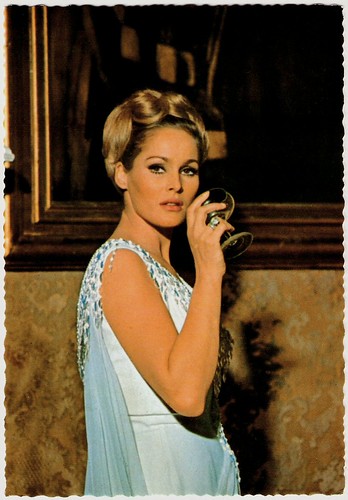
German postcard by ISV, no. H 134.
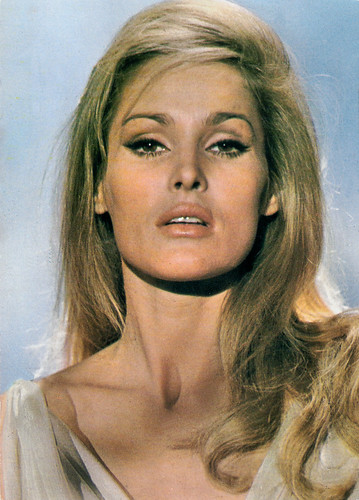
Belgian postcard by Edt. Decker, Brussels, no. A 113.
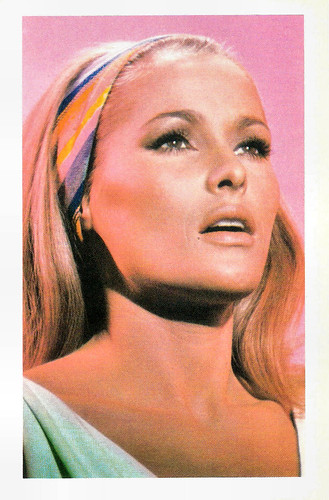
Vintage postcard.
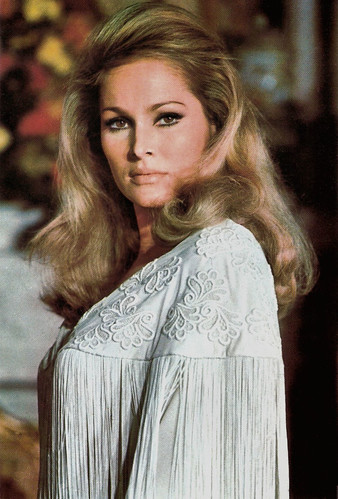
Spanish postcard by Postales Recuadro Blanco Vikingo, Barcelona, no. 441.
Ursula Andress's charms seemed not to diminish by age. At 40, she could still easily play a bombshell nurse hired to titillate a doddering millionaire to death in the slight Italian sex comedy L'infermiera/The Sensuous Nurse (Nello Rossati, 1975), and three years later she even appeared naked on a stake being rubbed with blood in the ‘horror in the jungle’ exploitation film La montagna del dio cannibale/Slave of the Cannibal God (Sergio Martino, 1978).
Having been divorced by Derek in 1966 so he could pursue younger lookalike Linda Evans, Andress played the field for years, reportedly involved at various times with Jean-Paul Belmondo, Ryan O'Neal, Warren Beatty and Fabio Testi.
In 1979 she began what would be a long-term romance with Harry Hamlin, her handsome young co-star from Clash of the Titans (Desmond Davis, 1981) in which she was cast, predictably, as Aphrodite. In 1980, Andress and Hamlin had a son, Dimitri Hamlin. After her son's birth, Andress scaled back her career.
Andress now focused mostly on European television and films, while she was raising Dimitri in Rome. Among her later films were Krasnye kolokola/Mexico in Flames (Sergei Bondarchuk, 1982) with Franco Nero, Liberté, égalité, choucroute/Liberty, Equality, Sauerkrauten (Jean Yanne, 1985) as Queen Marie Antoinette, and the art film Cremaster 5 (Matthew Barney, 1997).
On television she appeared in the mini-series Peter the Great (Marvin J. Chomsky, Lawrence Schiller, 1986) and in the series Falcon Crest (1988). Most recently she worked on a film in her home country Switzerland. In the satire Die Vogelpredigt/The Bird Preachers (Clemens Klopfenstein, 2005) she appeared as the Virgin Mary.
Her relationship with Harry Hamlin ended in 1982, and since 1983 she has lived with Lorenzo Rispoli. Ostensibly retired from acting, Andress makes the rounds of charity events and pops up on talk shows around Europe every once in a while. She divides her time between family in Switzerland, friends in Spain and Virginia, and her properties in Rome and L.A.
In 2001 the white bikini from Dr. No sold for £35,000 at an auction, in a 2003 Survey by the British Channel 4 her rise from the sea was voted #1 in ‘the 100 Greatest Sexy Moments, and in 2008 the readers of the British newspaper Daily Mail voted her ‘Best Bond Girl of All Time’. Ursula Andress’ performance as Honey Rider has clearly made her an icon of the 20th Century.

French postcard by E.D.U.G., no. 467.
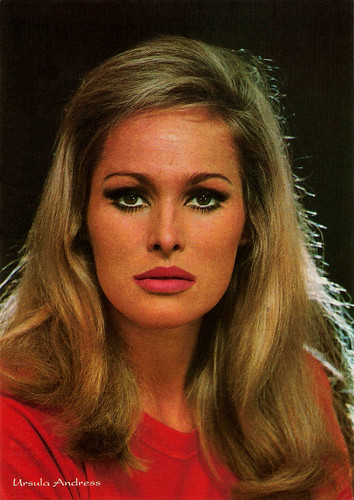
Italian postcard by Rotalfoto, Milano in the Artisti di Sempre series, no. 358.

Romanian postcard by Casa Filmului Acin, no. 43078.
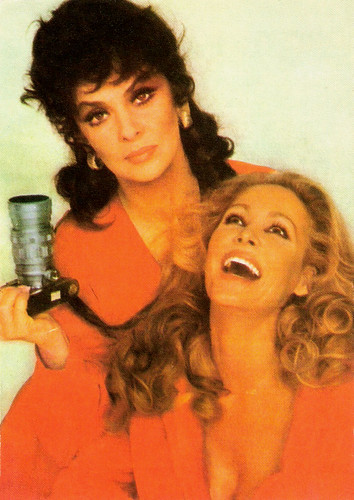
Romanian postcard by Casa Filmului Acin, no. 53189. With Gina Lollobrigida.
Original trailer of Dr. No (1962). Source: ChocolateFrogPrince (YouTube).
Clip from She (1965). Ursula demonstrates why She Must Be Obeyed. Source: DrCForbin (YouTube).
Ursula Andress in L'infermiera (1975). Source: Limesrgreat (YouTube).
Sources: Larry-115 (IMDb), Hal Erickson (AllMovie), Wikipedia, and IMDb.

German postcard by Krüger, no. 902/411.

Spanish postcard by Raker, no. 1157, 1965.

Spanish postcard, no. 240, 1964.
Impressive Physical Attributes
Ursula Andress was born in 1936, in Ostermundigen in the Swiss canton Bern, as one of seven children in a German Protestant family. Her father Rolf Andress was a German diplomat who disappeared during World War II, and her Swiss mother, Anna Andress, was a florist. The third of six children. She has a brother, Arthur and four sisters, Erica, Kàtey, Charlotte and Ruth. She and her siblings were raised by their grandparents. Her younger sister, Kàtey Andress, later unsuccessfully attempted to start a modelling career.
Although often seeming icily aloof, a restless streak early demonstrated itself in her personality, and Andress had a desire from an early age to explore the world outside Switzerland. At 17, she ran away with an Italian actor, then returned home after her mother intervened.
She studied painting, sculpture and dance in Paris. Andress started her career as an art model in Rome, which led to her first roles in the Italian film industry. (Some sources claim that she was on a holiday to Rome at the time). She played small roles in the Italian farces Un americano a Roma/An American in Rome (Steno, 1954), La catena dell'odio/The Chain of Hate (Renato Baldini, 1955) and Le avventure di Giacomo Casanova/Adventures of Giacomo Casanova (Steno, 1955), which focused on her impressive physical attributes.
Eventually, due in part to the patronage of paramour Marlon Brando, she signed a contract with Columbia Pictures and went to Hollywood heralded as the 'New Marlene Dietrich'. Actually the only things she had in common with Dietrich were her (partly) German heritage and her magnificent legs.
In Hollywood she had a troubled relationship with James Dean. One tabloid reported at the time that Dean was learning German so they could "argue in another language". On the day of his death (30 September 1955), Dean asked her to go with him to San Francisco in his Porsche 550 Spyder, but he had to leave Los Angeles without her.
Andress had met actor and pretty-boy John Derek and had fallen in love with him. They married in 1957, and Ursula dropped out of film-making for several years thereafter.

Serbian postcard by Cik Razolednica. Photo: publicity still for Dr. No (1962).

German postcard by ISV, Sort. 12/6.

German postcard by Rüdel-Verlag. Photo: Warner Bros. Publicity still for 4 For Texas (Robert Aldrich, 1963).

Spanish postcard by Postal Oscarcolor, no. 251. Photo: RCA. Publicity still for Fun in Acapulco (Richard Thorpe, 1963) with Elvis Presley and Elsa Cardenas.

Italian postcard. Photo: Dear Film. Publicity still for Les tribulations d'un Chinois en Chine/Up to His Ears (Philippe de Broca, 1965) with Jean-Paul Belmondo.

Spanish postcard by Postal Oscarcolor, no. 481. Photo: publicity still for Les tribulations d'un Chinois en Chine/Up to His Ears (Philippe de Broca, 1965) with Jean-Paul Belmondo.
Honey Rider
The year 1962 saw Ursula Andress back on the set, co-starring as Honey Ryder with Sean Connery in the first film version of Ian Fleming's James Bond spy novels, Dr. No (Terence Young, 1962).
On a trip to Greece, John Derek had taken photographs of his wife, and one had been published in a magazine. The photograph was seen by Harry Saltzman, co-producer of the first Bond film, which was scheduled to start shooting within a few weeks even though the female lead had not yet been cast. One glance at the picture was enough. Ursula was offered the part.
Her Swiss/German accent was so strong that her voice had to be dubbed, but Ursula Andress' smouldering-yet-aloof screen presence immediately established her as one of the most desired women in the world. Her performance helped to start the James Bond franchise and set the Bond Girl standard beside which all future Bond actresses would be judged.
In 1964 Andress won even a Golden Globe award for New Star of the Year for her role. The success of Dr. No established Ursula Andress as a spectacular ornament to put on-screen alongside the most bankable talent of the 1960s, and she was cast in Hollywood vehicles for such icons as the 'king of rock 'n' roll', Elvis Presley, in Fun in Acapulco (Richard Thorpe, 1963), and Frank Sinatra in 4 for Texas (Robert Aldrich, 1963).
In Europe she starred with Jean-Paul Belmondo in the Jules Verne adventure Les tribulations d'un chinois en Chine/Up to His Ears (Philippe de Broca, 1965) and with Marcello Mastroianni in the SF thriller La decima vittima/The 10th Victim (Elio Petri, 1965), in which she wears a famously ballistic bra.
She also featured as ‘Ayesha - She who must be obeyed’ in Hammer's fantasy film She (Robert Day, 1965) with Peter Cushing and Christopher Lee. In 1965, she also posed nude for Playboy - the photos were taken by husband John Derek. In The Blue Max (John Guillermin, 1966), she was aptly cast as the sultry, sexually insatiable wife of an aristocratic World War I German general, played by James Mason.
Andress also appeared in the Bond satire Casino Royale (John Huston a.o., 1967) as Vesper Lynd, an occasional spy who persuades Evelyn Tremble (Peter Sellers) to carry out a mission. And she was one of several European starlets to co-star in What's New Pussycat (Clive Donner, Richard Talmadge, 1965) - a film that perhaps sums up mid-196’s pop culture best - written by Woody Allen, starring Allen and Peter Sellers, with music by Burt Bacharach, a title song performed by Tom Jones and much on-screen sexual romping.

German postcard by Krüger, no. 902/412.

German postcard by ISV, no. H 134.

Belgian postcard by Edt. Decker, Brussels, no. A 113.

Vintage postcard.

Spanish postcard by Postales Recuadro Blanco Vikingo, Barcelona, no. 441.
Horror in the Jungle
Ursula Andress's charms seemed not to diminish by age. At 40, she could still easily play a bombshell nurse hired to titillate a doddering millionaire to death in the slight Italian sex comedy L'infermiera/The Sensuous Nurse (Nello Rossati, 1975), and three years later she even appeared naked on a stake being rubbed with blood in the ‘horror in the jungle’ exploitation film La montagna del dio cannibale/Slave of the Cannibal God (Sergio Martino, 1978).
Having been divorced by Derek in 1966 so he could pursue younger lookalike Linda Evans, Andress played the field for years, reportedly involved at various times with Jean-Paul Belmondo, Ryan O'Neal, Warren Beatty and Fabio Testi.
In 1979 she began what would be a long-term romance with Harry Hamlin, her handsome young co-star from Clash of the Titans (Desmond Davis, 1981) in which she was cast, predictably, as Aphrodite. In 1980, Andress and Hamlin had a son, Dimitri Hamlin. After her son's birth, Andress scaled back her career.
Andress now focused mostly on European television and films, while she was raising Dimitri in Rome. Among her later films were Krasnye kolokola/Mexico in Flames (Sergei Bondarchuk, 1982) with Franco Nero, Liberté, égalité, choucroute/Liberty, Equality, Sauerkrauten (Jean Yanne, 1985) as Queen Marie Antoinette, and the art film Cremaster 5 (Matthew Barney, 1997).
On television she appeared in the mini-series Peter the Great (Marvin J. Chomsky, Lawrence Schiller, 1986) and in the series Falcon Crest (1988). Most recently she worked on a film in her home country Switzerland. In the satire Die Vogelpredigt/The Bird Preachers (Clemens Klopfenstein, 2005) she appeared as the Virgin Mary.
Her relationship with Harry Hamlin ended in 1982, and since 1983 she has lived with Lorenzo Rispoli. Ostensibly retired from acting, Andress makes the rounds of charity events and pops up on talk shows around Europe every once in a while. She divides her time between family in Switzerland, friends in Spain and Virginia, and her properties in Rome and L.A.
In 2001 the white bikini from Dr. No sold for £35,000 at an auction, in a 2003 Survey by the British Channel 4 her rise from the sea was voted #1 in ‘the 100 Greatest Sexy Moments, and in 2008 the readers of the British newspaper Daily Mail voted her ‘Best Bond Girl of All Time’. Ursula Andress’ performance as Honey Rider has clearly made her an icon of the 20th Century.

French postcard by E.D.U.G., no. 467.

Italian postcard by Rotalfoto, Milano in the Artisti di Sempre series, no. 358.

Romanian postcard by Casa Filmului Acin, no. 43078.

Romanian postcard by Casa Filmului Acin, no. 53189. With Gina Lollobrigida.
Original trailer of Dr. No (1962). Source: ChocolateFrogPrince (YouTube).
Clip from She (1965). Ursula demonstrates why She Must Be Obeyed. Source: DrCForbin (YouTube).
Ursula Andress in L'infermiera (1975). Source: Limesrgreat (YouTube).
Sources: Larry-115 (IMDb), Hal Erickson (AllMovie), Wikipedia, and IMDb.
6 comments:
Oh, definitely Ursula! I like Halle Berry, but not in a Bond movie!
Wow! Great post. I loved the writeup and the videos. I'm a huge fan of Ursula. You've got a really cool blog. I hope this finds you doing well. Cheers!
Ursula! Incomparable!
It seems Ursula Andress is a most enduring movie star . Which is not not the same an enduring actress .
She was breathtakingly beautiful in films with her exotic and very European looks ,
spanning for over 40 years !
Still is an interesting woman , celebrating her 80th birthday this year .
Yes, she's an icon. A breathtaking one.
The Italian postcards number 3 and 4 shown here is NOT Ursula Andress .
The mistake is early portraits is often made .
The lady in these postcards is another sex symbol of the same period : Raquel Welch !
Post a Comment